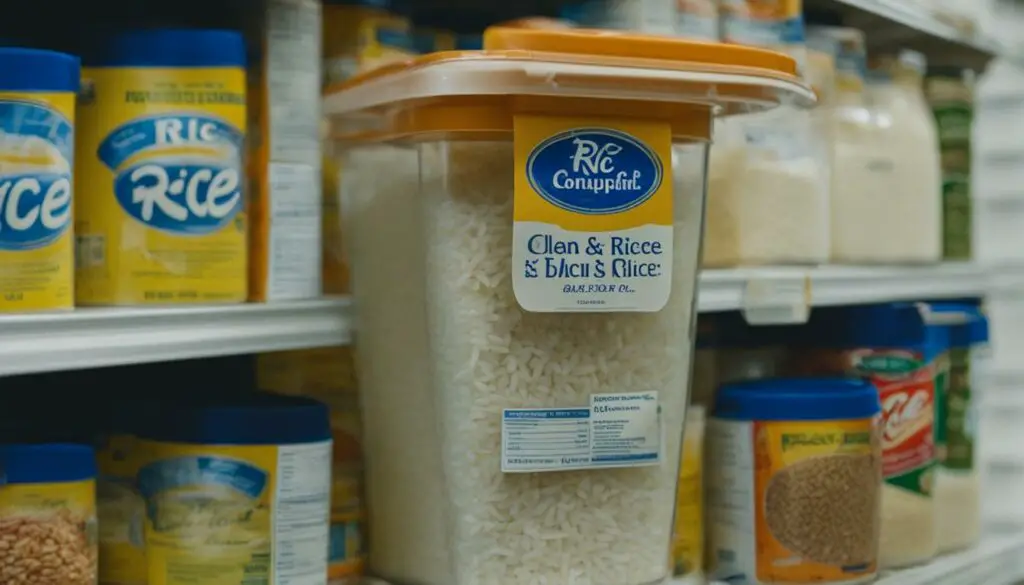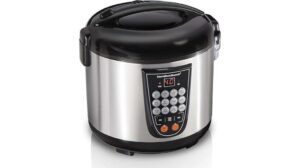In this article, we will reveal the best techniques and tips to ensure that your rice remains fresh, whether it’s white rice, brown rice, or any other variety. Discover the secrets to storing rice correctly, preserving its freshness, and enhancing its taste.
By the end of this article, you’ll have all the knowledge you need to keep your favorite rice dishes tasting delicious and make sure your rice always stays fresh and flavorful. Let’s dive in!
Table of Contents
Understanding Rice Freshness and Storage Fundamentals
Proper storage techniques are crucial for maintaining the freshness of rice. It is important to understand the fundamentals of rice freshness and how to store it correctly to ensure its longevity and quality. This section will explore the importance of proper storage techniques, as well as the factors that can affect rice quality over time.
The Importance of Proper Storage Techniques
When it comes to storing rice, using the right techniques is essential. Airtight containers are key to keeping rice fresh by preventing exposure to moisture, pests, and air. Moisture can lead to the growth of bacteria and fungi, while pests can contaminate the rice. Storing rice in cool, dry places further helps maintain its freshness and prevents it from spoiling.
By using proper storage techniques, you can ensure that your rice stays fresh and flavorful for a longer period. Investing in high-quality storage containers and following best practices will help preserve the quality of your rice and prevent any potential food waste.
Evaluating the Factors Affecting Rice Quality Over Time
Various factors can affect the quality of rice over time, leading to changes in taste, texture, and nutritional value. It is important to be aware of these factors to understand how to store rice effectively.
Temperature plays a significant role in rice quality preservation. Storing rice in high temperatures can accelerate the deterioration process, resulting in a shorter shelf life and diminished quality. Similarly, humidity can promote the growth of bacteria and fungi, leading to spoilage. Exposure to light can also degrade rice quality, causing it to lose its natural color and nutritional content.
By considering these factors and implementing proper storage techniques, you can maintain the freshness and quality of rice, ensuring a delightful culinary experience.
How to Keep Rice Fresh: Selecting the Ideal Storage Containers
The choice of storage containers plays a significant role in keeping rice fresh. To ensure optimal storage, it is essential to select containers that provide airtight seals and maintain cleanliness and dryness. Let’s explore some of the ideal storage containers for rice:
1. Food-Grade Plastic Containers: Food-grade plastic containers are an excellent choice for storing rice. Opt for containers with airtight lids to prevent moisture and pests from contaminating the rice. These containers are lightweight, easy to handle, and come in various sizes to accommodate different quantities of rice.
2. Glass Jars with Tight-Fitting Lids: Glass jars with tight-fitting lids are another excellent option for rice storage. These jars are not only aesthetically pleasing but also provide an airtight seal, keeping the rice fresh for a longer period. Glass jars are also easy to clean and do not retain odors, ensuring that the rice maintains its natural taste.
When selecting storage containers, it’s important to consider factors like durability, ease of use, and convenience. Remember to clean and dry the containers thoroughly before storing rice to prevent any contamination. By choosing the right storage containers, you can extend the freshness and quality of your rice.
Maintaining Optimal Storage Conditions for Rice
To maintain the freshness and quality of rice, it is crucial to store it under optimal conditions. By creating the right environment, you can preserve the taste, texture, and nutritional value of rice for an extended period. In this section, we will explore the best temperature and humidity levels for preserving rice freshness and discuss how to shield rice from harmful environmental factors that can affect its quality.
Best Temperature and Humidity for Preserving Rice Freshness
The storage temperature plays a vital role in maintaining the freshness of rice. It is recommended to store rice at a temperature below 77°F (25°C) to prevent the growth of bacteria and fungi. Higher temperatures can accelerate the degradation process and lead to a loss in taste and texture. For optimal freshness, aim to store rice in a cool and dry place, away from direct sunlight and heat sources.
Humidity is another critical factor to consider when storing rice. High levels of humidity can promote the growth of mold and mildew, causing the rice to spoil quickly. It is best to store rice in an environment with a humidity level below 70%. To further protect the rice from moisture, consider using airtight containers or adding desiccant packs to absorb excess moisture.
Shielding Rice from Harmful Environmental Factors
In addition to temperature and humidity, it is essential to shield rice from other environmental factors that can compromise its quality. Exposure to heat, sunlight, and moisture can accelerate the degradation process and lead to rancidity or mold growth. To protect rice from these harmful factors:
- Store rice in airtight containers to minimize exposure to air and moisture.
- Keep rice away from direct sunlight or any other sources of light.
- Place rice in a dry and clean area, free from any potential contaminants.
- Avoid storing rice near strong odors that can be absorbed and affect its flavor.
By following these protective measures, you can ensure that your stored rice remains fresh and of high quality, ready to be enjoyed in your favorite dishes.
| Storage Conditions | Temperature | Humidity |
|---|---|---|
| Ideal | Below 77°F (25°C) | Below 70% |
| Recommended | Below 86°F (30°C) | Below 80% |
| Avoid | Above 104°F (40°C) | Above 80% |
How to Store Rice for Long-Term Freshness
If you want to store rice for an extended period, there are several tips and techniques you can follow to ensure long-term freshness. Proper packaging is crucial to protect rice from moisture, pests, and oxidation. Consider using vacuum-sealed bags, mylar bags, or food-grade buckets to store your rice. These containers provide an airtight seal, preventing the entry of air and humidity that can lead to spoilage.
Additionally, the use of oxygen absorbers can help eliminate oxygen from the storage environment, further prolonging the freshness of the rice. Oxygen absorbers are small packets that contain iron powder, which reacts with oxygen to create a vacuum inside the container. This process prevents the growth of bacteria and fungus, maintaining the quality of the stored rice.

By employing these packaging methods and utilizing oxygen absorbers, you can ensure that your stored rice remains fresh for an extended period, retaining its nutritional value and taste.
Preventing Rice from Spoiling: Tips and Tricks
In this section, we will share practical tips and tricks for preventing rice spoilage and extending its shelf life. By implementing these techniques, you can ensure that your rice remains fresh and flavorful for longer periods of time.
Handling and Rotation Techniques to Extend Rice Shelf Life
Proper handling and regular rotation are essential for maximizing the shelf life of rice. Follow these tips to extend the freshness of your rice:
- Store rice in airtight containers: Transfer your rice to airtight containers to protect it from moisture, pests, and exposure to air. This will help prevent spoilage and maintain its quality.
- Keep rice in a cool and dry place: Rice should be stored in a cool and dry location, away from direct sunlight and heat sources. Avoid storing rice near the stove or in humid areas, as these conditions can accelerate spoilage.
- Rotate your rice supply: It’s important to use the “first in, first out” principle when consuming rice. Rotate your rice stock so that older batches are used before newer ones, ensuring that your supply stays fresh.
Identifying and Addressing Signs of Rice Deterioration
To prevent the consumption of spoiled rice, it’s crucial to be able to identify the signs of rice deterioration. Look out for the following indicators:
- Musty odor: Rice that has a strong, unpleasant odor is likely spoiled and should not be consumed.
- Discoloration: If you notice any discoloration, such as dark spots or patches on the rice grains, it’s a sign of deterioration.
- Mold presence: The presence of mold indicates that the rice has been contaminated and is no longer safe to eat.
If you come across any of these signs, it’s best to discard the rice to prevent any potential health risks. Regularly inspecting your rice supply and promptly addressing any signs of deterioration will help maintain the quality and safety of your rice.
| Preventing Rice Spoilage: Tips and Tricks |
|---|
| Tip 1: Store in airtight containers |
| Transfer rice to airtight containers to protect it from moisture, pests, and air exposure. |
| Tip 2: Keep in a cool, dry place |
| Store rice in a cool and dry location, away from heat sources and direct sunlight. |
| Tip 3: Rotate your rice supply |
| Follow the “first in, first out” principle by using older rice batches before newer ones. |
| Signs of Rice Deterioration |
| Sign 1: Musty odor |
| Spoiled rice may emit a strong, unpleasant odor. |
| Sign 2: Discoloration |
| Dark spots or patches on rice grains indicate deterioration. |
| Sign 3: Presence of mold |
| Mold on rice is a clear sign of contamination and should be discarded. |
Innovative Rice Storage Methods and Technologies
Advancements in technology have introduced innovative rice storage methods. These new approaches and technologies make use of special containers with ventilation and moisture regulation features, ensuring optimal rice storage and freshness.
By incorporating these innovative methods, you can preserve the quality and taste of your rice for longer periods, reducing the risk of spoilage and waste. These new technologies provide better control over environmental factors that can affect the freshness of rice, such as humidity and airflow.
One such technology is the use of smart containers equipped with sensors that monitor and regulate the internal conditions. These containers can adjust humidity levels, ensuring the ideal moisture content for rice storage. With their advanced ventilation systems, they facilitate the proper circulation of air, preventing the growth of mold and mildew.
Another innovative method is the use of vacuum-sealed bags specially designed for rice storage. These bags eliminate oxygen, which is one of the main factors contributing to rice spoilage. By removing oxygen, these bags create an oxygen-free environment, inhibiting the growth of bacteria and fungi that can degrade the quality of rice.
- Generous Storage Space: This rice storage container has a capacity of 25.4lb (11.3kg), enabling longer storage of rice and maintaining its hygiene. Its versatile in storing other small grains like soybeans, corn, sago, and beans.
- Superb Air Sealing: Constructed with high-quality PP material, this grain dispenser offers durable long-term use. Its lid contains a sealing ring that guarantees excellent airtightness and maintains rice freshness. Additionally, it is smell-proof, ensuring safe storage of your grains.
- User-friendly: To dispense rice, simply press the button and release to stop. Transparent scales on both the dispenser and measuring cup allow you to intuitively see how much rice remains and how much has been measured. Additionally, its easy to disassemble and clean.
- Versatile Measuring Cup: The accompanying measuring cup is transparent, facilitating clear visibility and accuracy with its marked scale, allowing for easy rice measurement. The cup also features small drainage holes along its edge, enabling direct rice washing with ease.
- Space-saving: The rice dispenser boasts a stylish and versatile design, ideal for various home aesthetics. Its compact size aids in maintaining a tidy kitchen without occupying excessive spa
Prices pulled from the Amazon Product Advertising API on:
Product prices and availability are accurate as of the date/time indicated and are subject to change. Any price and availability information displayed on [relevant Amazon Site(s), as applicable] at the time of purchase will apply to the purchase of this product.
Furthermore, there are technologies that utilize natural compounds and organic materials to enhance rice storage. Some containers are made with materials infused with herbs or essential oils known for their antimicrobial properties. These natural substances help to inhibit the growth of microorganisms that can cause rice to spoil.
When exploring these innovative storage methods and technologies, it’s essential to consider the specific needs of the rice you are storing, such as the variety and moisture content. By choosing the most suitable method for your rice, you can extend its shelf life and maintain its freshness and taste.
Storing Cooked versus Uncooked Rice: What You Need to Know
When it comes to storing rice, whether cooked or uncooked, it’s important to understand the differences in storage strategies for each. Proper storage techniques not only help maintain the freshness and quality of rice but also ensure its safety for consumption. In this section, we will explore the variations in storage techniques between cooked and uncooked rice and provide special considerations for keeping cooked rice tasty and safe.
Differences in Storage Strategies for Cooked and Uncooked Rice
Uncooked rice, in its raw form, has a longer shelf life compared to cooked rice. Here are the key differences in storage strategies:
- Storage containers: Uncooked rice can be stored in airtight containers, such as pantry or kitchen cabinets, as long as they are kept in a cool, dry place. Cooked rice, on the other hand, requires special attention to prevent bacterial growth. It is recommended to store cooked rice in airtight containers in the refrigerator.
- Cooling: Uncooked rice does not require any specific cooling process before storage. However, when storing cooked rice, it is crucial to cool it down quickly to minimize the risk of bacteria growth. Spread the cooked rice on a tray or shallow container and let it cool to room temperature before transferring it to the storage container.
Special Considerations for Keeping Cooked Rice Tasty and Safe
When storing cooked rice, there are additional considerations to ensure its taste and safety:
- Refrigeration: Cooked rice should be stored in the refrigerator at or below 40°F (4°C). This helps slow down the growth of bacteria that can cause foodborne illnesses.
- Timing: It is recommended to consume cooked rice within 3-4 days of refrigerating it. Discard any leftover rice that has been stored for longer to avoid the risk of food poisoning.
- Proper reheating: When reheating cooked rice, ensure it reaches a temperature of 165°F (74°C) throughout to kill any bacteria present. Reheating in small portions is advisable to maintain the best quality.
By following these storage strategies and considerations, you can effectively store both cooked and uncooked rice, ensuring their freshness, taste, and safety for your meals.
Conclusion
In conclusion, proper storage techniques are vital for maintaining the freshness and taste of your rice. Throughout this article, we have covered a variety of tips and strategies to help you keep your rice fresh for an extended period. By implementing these suggestions, you can ensure that your rice remains enjoyable in every meal.
We began by discussing the importance of selecting the ideal storage containers. Using airtight containers such as food-grade plastic containers or glass jars with tight-fitting lids can significantly contribute to maintaining the quality of your rice.
We then explored the significance of optimal storage conditions, including temperature and humidity levels. Storing rice in cool, dry places, shielded from harmful environmental factors such as heat, sunlight, and moisture, can enhance its longevity.
Lastly, we provided tips on preventing rice spoilage and extending its shelf life. Proper handling and rotation techniques, as well as promptly identifying and addressing signs of rice deterioration, are crucial for ensuring your rice stays fresh and safe to consume.
By following these rice storage tips, you can enjoy delicious and flavorful rice in your favorite dishes for as long as possible. Remember, proper storage is key to preserving the freshness and taste of this versatile staple food.
FAQ
How can I keep rice fresh for longer?
To keep rice fresh for longer, store it in airtight containers in cool, dry places. Avoid exposure to moisture and pests, and select the proper storage containers and conditions.
What are the fundamentals of rice freshness and storage?
The fundamentals of rice freshness and storage include understanding the importance of proper storage techniques and evaluating the factors that can affect rice quality over time, such as temperature, humidity, and exposure to light.
What types of storage containers are ideal for rice?
Food-grade plastic containers and glass jars with tight-fitting lids are ideal for storing rice. It is crucial to ensure cleanliness and dryness when selecting storage containers for rice.
What are the optimal storage conditions for rice?
The best temperature for preserving rice freshness is cool, and the humidity level should be low. It is also important to shield rice from harmful environmental factors such as heat, sunlight, and moisture.
How can I store rice for long-term freshness?
For long-term rice storage, consider using packaging options like vacuum-sealed bags, mylar bags, or food-grade buckets. The use of oxygen absorbers can help eliminate oxygen and prolong rice freshness.
How can I prevent rice from spoiling?
To prevent rice from spoiling, follow proper handling and rotation techniques. This can help extend the shelf life of rice. Additionally, be vigilant in identifying signs of rice deterioration, such as a musty odor, discoloration, or the presence of mold, and address them effectively.
Are there any innovative rice storage methods or technologies available?
Yes, advancements in technology have introduced innovative rice storage methods. These include special containers with ventilation and moisture regulation features to ensure optimal rice storage and freshness.
Are there any special considerations for storing cooked rice?
Yes, storing cooked rice requires specific strategies. Proper cooling and airtight containers are essential for preserving the taste and safety of cooked rice.






